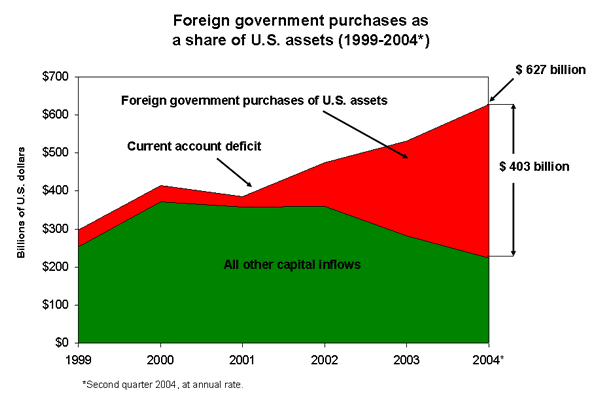See Snapshots Archive.
This Snapshot originally appeared on March 22. It has been updated reflect the release of new data from the Bureau of Economic Analysis.
Snapshot for September 14, 2004.
Foreign governments finance a growing share of U.S. trade deficit
The Bureau of Economic Analysis announced today that the current account (the broadest measure of the U.S. deficit in trade of goods, services, and payments to the rest of the world) reached an all-time quarterly high of $166.2 billion in the second quarter of 2004, an increase of 13% over the previous quarter. This trade deficit was 5.7% of U.S. gross domestic product (GDP). A major factor contributing to the rising trade deficit is the effort by foreign governments (especially those in Asia) to boost the value of the U.S. dollar by purchasing large amounts of U.S. assets such as treasury bills and other government securities. Foreign governments now provide the majority of the financing required to support the U.S. trade deficit.
A trade deficit must be financed by net borrowing from the rest of the world. The United States was effectively spending about 5.7% more than it was producing in the first quarter, about $1.8 billion every day. The United States cannot continue to borrow at such a high rate indefinitely. Worse yet, the trade deficit is growing each year as a share of GDP. The drop in the value of the dollar since February 2002—primarily the 40% decline against the Euro—has failed to stem the increase in the current account deficit, which was 4.3% of GDP at the dollar’s peak.
If the dollar were being supported by demand from investors who find the U.S. market attractive, then steady growth in capital inflows from private investors to finance rising deficits would likely occur. However, private inflows have fallen in the last three years. Instead, foreign governments have been intervening in foreign exchange markets by purchasing a rapidly growing volume of U.S. government assets (shown as foreign government purchases of U.S. assets in the figure below). These inflows reached an annual rate of $403 billion in the first half of 2004, or 64% of the funds necessary to finance the U.S. deficit. Official government inflows were 47% of the total in 2003.

Asian governments made 80.7% of all government purchases of U.S. assets in the first half of 2004. Asian governments, especially Japan and China, are willing to absorb the risks of financial losses from an ultimate decline in the dollar in order to support their exports competing with U.S. production, in the United States and around the world. If these governments had not been intervening in foreign exchange markets, then the dollar would have fallen much more than it has since 2002. In fact, the real value of the dollar increased 2.8% in the first half of 2004. This would not have occurred without the intervention of foreign governments in currency markets.
According to news reports, Japanese authorities reduced official purchases of foreign exchange in the second quarter, as the Yen weakened during the quarter. Available evidence suggests that Japanese officials would intervene again in the future were the Yen to strengthen. Chinese authorities have stated that they will also act to maintain the stability of their currency, and China continued to acquire foreign exchange during the quarter. If U.S. and foreign governments would arrange for a substantial, orderly decline in the value of the dollar, then financial markets could be stabilized and the U.S. trade deficit would begin to decline.
This Snapshot was written by EPI Economist Robert E. Scott, with research assistance from David Ratner.
